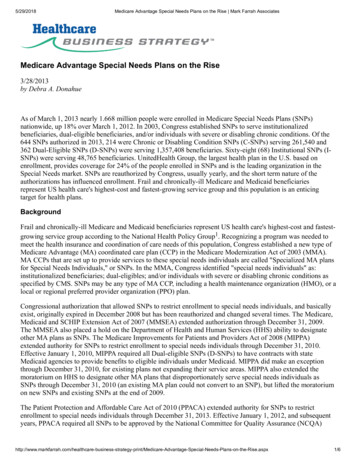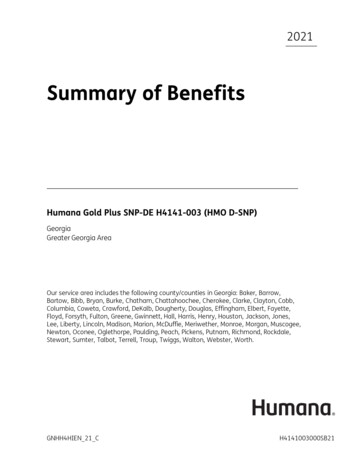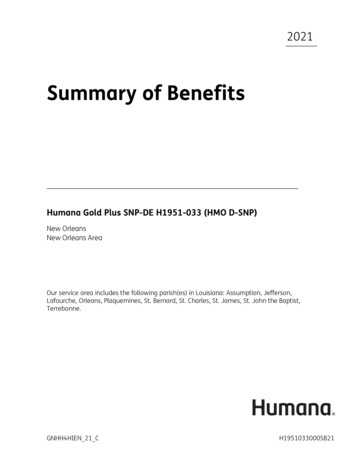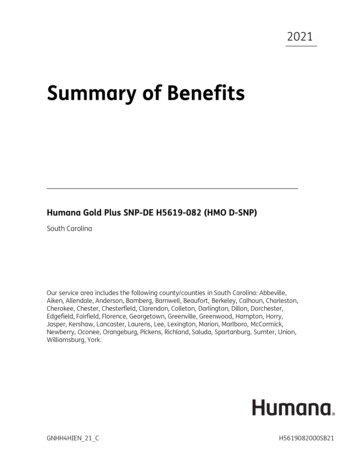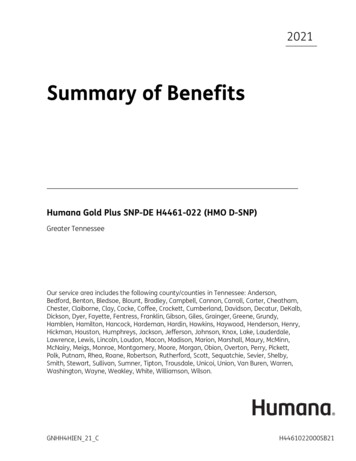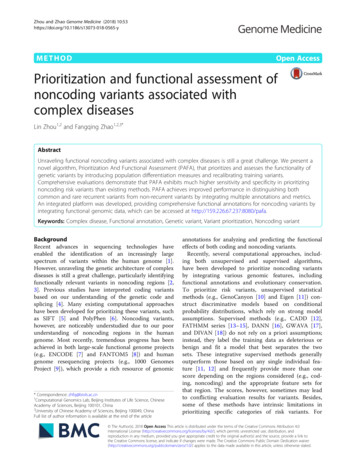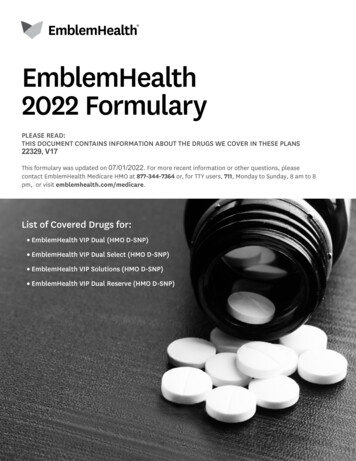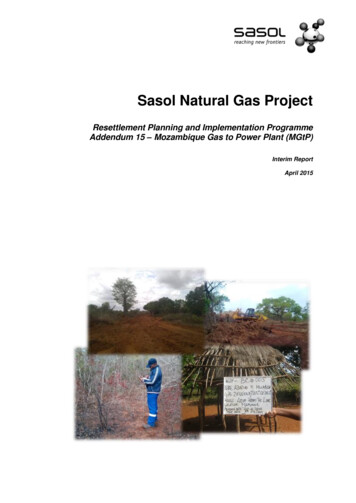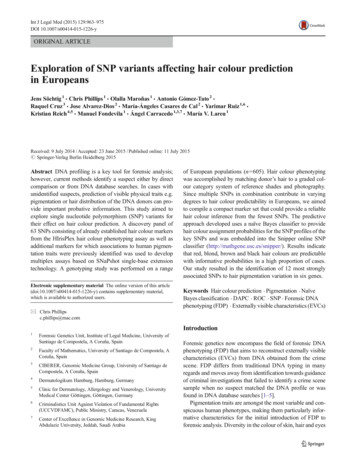
Transcription
Int J Legal Med (2015) 129:963–975DOI 10.1007/s00414-015-1226-yORIGINAL ARTICLEExploration of SNP variants affecting hair colour predictionin EuropeansJens Söchtig 1 & Chris Phillips 1 & Olalla Maroñas 1 & Antonio Gómez-Tato 2 &Raquel Cruz 3 & Jose Alvarez-Dios 2 & María-Ángeles Casares de Cal 2 & Yarimar Ruiz 1,6 &Kristian Reich 4,5 & Manuel Fondevila 1 & Ángel Carracedo 1,3,7 & María V. Lareu 1Received: 9 July 2014 / Accepted: 23 June 2015 / Published online: 11 July 2015# Springer-Verlag Berlin Heidelberg 2015Abstract DNA profiling is a key tool for forensic analysis;however, current methods identify a suspect either by directcomparison or from DNA database searches. In cases withunidentified suspects, prediction of visible physical traits e.g.pigmentation or hair distribution of the DNA donors can provide important probative information. This study aimed toexplore single nucleotide polymorphism (SNP) variants fortheir effect on hair colour prediction. A discovery panel of63 SNPs consisting of already established hair colour markersfrom the HIrisPlex hair colour phenotyping assay as well asadditional markers for which associations to human pigmentation traits were previously identified was used to developmultiplex assays based on SNaPshot single-base extensiontechnology. A genotyping study was performed on a rangeElectronic supplementary material The online version of this article(doi:10.1007/s00414-015-1226-y) contains supplementary material,which is available to authorized users.* Chris Phillipsc.phillips@mac.comof European populations (n 605). Hair colour phenotypingwas accomplished by matching donor’s hair to a graded colour category system of reference shades and photography.Since multiple SNPs in combination contribute in varyingdegrees to hair colour predictability in Europeans, we aimedto compile a compact marker set that could provide a reliablehair colour inference from the fewest SNPs. The predictiveapproach developed uses a naïve Bayes classifier to providehair colour assignment probabilities for the SNP profiles of thekey SNPs and was embedded into the Snipper online SNPclassifier (http://mathgene.usc.es/snipper/). Results indicatethat red, blond, brown and black hair colours are predictablewith informative probabilities in a high proportion of cases.Our study resulted in the identification of 12 most stronglyassociated SNPs to hair pigmentation variation in six genes.Keywords Hair colour prediction . Pigmentation . NaïveBayes classification . DAPC . ROC . SNP . Forensic DNAphenotyping (FDP) . Externally visible characteristics (EVCs)Introduction1Forensic Genetics Unit, Institute of Legal Medicine, University ofSantiago de Compostela, A Coruña, Spain2Faculty of Mathematics, University of Santiago de Compostela, ACoruña, Spain3CIBERER, Genomic Medicine Group, University of Santiago deCompostela, A Coruña, Spain4Dermatologikum Hamburg, Hamburg, Germany5Clinic for Dermatology, Allergology and Venerology, UniversityMedical Center Göttingen, Göttingen, Germany6Criminalistics Unit Against Violation of Fundamental Rights(UCCVDFAMC), Public Ministry, Caracas, Venezuela7Center of Excellence in Genomic Medicine Research, KingAbdulaziz University, Jeddah, Saudi ArabiaForensic genetics now encompass the field of forensic DNAphenotyping (FDP) that aims to reconstruct externally visiblecharacteristics (EVCs) from DNA obtained from the crimescene. FDP differs from traditional DNA typing in manyregards and moves away from identification towards guidanceof criminal investigations that failed to identify a crime scenesample when no suspect matched the DNA profile or wasfound in DNA database searches [1–5].Pigmentation traits are amongst the most variable and conspicuous human phenotypes, making them particularly informative characteristics for the initial introduction of FDP toforensic analysis. Diversity in the colour of skin, hair and eyes
964is mainly determined by production of melanin, representedby the two distinct forms of eumelanin (brown to black) andpheomelanin (yellow to reddish-brown) [6]. Variation in hairpigmentation is predominantly confined to Europeans,reaching its maximum phenotypic range in an area centredon the Eastern Baltic extending over the North and East ofEurope. Outside Europe, hair colour is black with somenotable exceptions such as Near East [7] and Melanesianpopulations [8]. Within Europe, human hair colour rangesfrom the darkest black to the lightest white-blond hueswith numerous variations generally summarised intobroader colour categories: black, brown, blond and red,while sub-categories Bbrunette , Bchestnut brown ,Bauburn and Bstrawberry red are also recognised. Thisdiversity can be explained by positive selection favouringlight or fair pigmentation traits that has been in effect inEuropean populations for over 5000 years [9].Studies of the genetic basis of human pigmentation diversity indicate a high heritability and few genes playing a keyrole in determining hair colour [10–13]. Individual-specificdifferences are largely due to single-nucleotide polymorphisms (SNPs), with the largest proportion showing strongsignals of association to human pigmentation variation fromgenome-wide association studies (GWAS) [14–17]. The firsthuman polymorphisms recognised to have hair pigmentationassociation were in melanocortin 1 receptor (MC1R) [18], andsubsequently, melanocortin receptor protein was identified asa key regulator of melanogenesis [19]. Many of the numerousMC1R variants have strong association with the red hair colour (RHC) phenotype [20]. In contrast to red hair, blond hairhas been less extensively studied, but SNPs in TYRP1,TPCN2, KITLG and ASIP differentiate blond from other haircolours [16, 21, 22]. Black hair is commonly recognised as theancestral phenotype, with ASIP [23] and SLC45A2 [24, 25]SNP associations in Europeans.Forensic hair colour predictive tests aiming to exploit theabove SNP associations began with a test for 12 MC1R variants to predict red hair [26]. Several years later, these wereextended by Branicki et al. to analyse the full range ofEuropean hair colours [21]. The model developed byBranicki includes 11 SNPs in ten genes, together with twoMC1R classes of low-penetrance MC1R-r variants with recessive effect and high-penetrance MC1R-R variants with dominant effect. Branicki’s study assessed the scope for hair colourprediction with a multinomial logistic regression model andachieved area under the receiver operator characteristic curve(AUC) values 0.9 for red hair, almost 0.9 for black and 0.8for blond and brown hair. These studies formed the basis fordevelopment of the HIrisPlex system [27], a single multiplexof 24 eye and hair colour predictive markers, including 13 ofMC1R and incorporating four from IrisPlex [28]. HIrisPlexwas recently enhanced with a much larger reference databaseand an online predictive tool [29] that now provides predictiveInt J Legal Med (2015) 129:963–975accuracies of 69.5 % for blond hair, 78.5 % for brown, 80 %for red and 87.5 % for black.Although HIrisPlex already provides an informative androbust test system for predicting common pigmentation variation, we wished to explore a range of additional SNP variantstogether with new compilations of established SNP sets identified by previous studies, for their predictive value for haircolour variation in European populations. We previously developed a forensic eye colour predictive test comprising 13SNPs from analysis of 37 pigmentation-associated SNPs [30].The 37 SNPs formed two discovery panels termed SHEP 1and SHEP 2 (skin, hair and eye pigmentation), and in thisstudy, we added recently identified hair colour-associatedmarkers into a new SHEP 4 assay to assess 63 SNPs in total.The SHEP assays were used to genotype 605 subjects from 17European countries. Statistical analysis of genotype datagauged the predictive power of the analysed SNPs, includingamongst others, logistic regression (LR) analysis and discriminant analysis of principal components (DAPC).As with previous assessments of eye colour predictabilityfrom small-scale SNP tests, we centred the main pigmentationphenotype prediction strategy on a naïve Bayes system byuploading profiles to Snipper [http://mathgene.usc.es/snipper/index.php]. Snipper already contains links for theprediction of eye and skin colour, and to extend thisfunctionality, it has been updated with links for hair colour.The predictive value of a reduced set of the most closelyassociated hair SNPs was assessed with these same tools.Assessing the predictive performance of systematicallyreduced SNP sets for four hair colours provided a final set of12 markers most strongly associated with hair colour and thebest forensic classification framework for our data. Theaccuracy of the final set was assessed through receiveroperating characteristic (ROC) analysis and calculation ofthe associated AUC. The main aim of this study was to examine in detail the individual contribution of SNPs known to beassociated with hair colour and therefore informative for inference of hair colour in forensic analyses. For this reason, wecompiled a compact SNP set that maintains reasonable predictive performance but with differences in SNP componentsto those of HIrisPlex. It is important to emphasise that themain study objective was not to replace HIrisPlex but to contribute to a better understanding of the SNP variants that underlie hair colour phenotypes by comparing the key predictorsof both sets.Materials and methodsPopulation samplesSamples comprised 605 unrelated Europeans (63.8 % femalesand 36.2 % males) from 17 populations (Supplementary
Int J Legal Med (2015) 129:963–975Fig. S2). Donors were from Spain (284), Germany (228),Sweden (24), Austria (18), Italy (13), Denmark (10),Norway (6), England (6), Finland (4), Portugal (3),Netherlands (2), Poland (2), Bosnia (1), Slovakia (1),Luxembourg (1), Greece (1) and Switzerland (1). All participants gave informed consent, and ethical approval wasgranted from the clinical investigation ethics committee,Galicia, Spain (CEIC: 2009/246).Data was collected for participant’s grandparental ancestry,with individuals using hair colouring or with grey hair excluded from sampling altogether (not in the 605 collected). Lessfrequent hair colour phenotypes like Bwhite-blond andBcarrot-red were not intentionally enriched and reflect corresponding frequencies in sampled populations in Europe [7].To minimise hair tone variation due to the bleaching effects ofsun and saltwater exposure, samples were taken between autumn and winter. In addition to the University of Santiago deCompostela population set, we tested the performance of thepredictive approach developed in this work on an independently collected subset of individuals from Göttingen,Germany (n 63). Phenotypes for hair, eye and skin pigmentation were recorded by a dermatologist.Hair colour phenotypingThe phenotyping regime matched donor’s hair to the FischerSaller graded colour category system of 30 natural referenceshades (Supplementary Fig. S3, GPM AnthropologicalInstruments, Switzerland). The Fischer-Saller scale is a widelyused anthropological system for hair colour assessment [31]and uses letters from A (white-blond) through to Y (black),plus Roman numerals I–VI for red hair shades. The letter orRoman numeral was recorded at time of sample collection bya single scientist (not a dermatologist). For subjects with longhair, the proximal part of the hair shaft, least affected bybleaching effects, was examined. Hair colour was alsophotographed (12-megapixel reflex Canon EOS 1000D camera). To control photographic colour quality, a colour controlpatch was used (Kodak, USA), and the patch’s white sectionallowed white balance adjustment using GIMP softwarev.2.8.10. Hair phenotype descriptions were placed into threecategorical divisions of two, four or eight hair colours. Thetwo-category division of light and dark omitted red and darkblond to fair brown colours, similar to the light/dark shadephenotyping regime of HIrisPlex. Red hair individuals wereexcluded because the RHC phenotype is outside the continuous spectrum of light to dark and depends on a MC1R mutation spectrum. Since we only examined extreme tonalities,intermediate tones were also excluded. The four-category designation comprised red, blond, brown and black, corresponding to the widely used categorisation of hair colour used inBranicki’s study [21] and for HIrisPlex [27]. The eight category system differentiated fair and dark blond, light and dark965brown and black and placed red hair into carrot-red (orangecopper), auburn (reddish-brown) and blond-red. Hence, weapplied one category more than Branicki and HIrisPlex thatboth used a slightly different fine colour division for intermediate tones and did not consider fair blond as a category. Inaddition to hair colour, we obtained iris colour by applying thephenotyping approach of Ruiz et al. [30] to apply eye colouras a covariate in the logistic regression (LR) analysis of haircolour.Training and testing setsTraining sets, forming reference data for the predictive modelsapplied, were established by condensing all samples collectedinto a subset where hair colours were more clearly differentiated. Four scientists (not dermatologists, two Spanish, twoGerman) independently classified photographs unsupervised,into red, blond, brown and black categories. This photographic review did not refer to Fischer-Saller hair colour information, and samples not classified identically by all reviewerswere removed. A 230-sample training set of four hair colourswas established from 65 blond, 20 red, 90 brown and 55 blackindividuals. The remaining 375 samples formed the test set toassess predictive model performance.SNP selectionThe discovery set of 63 pigmentation-associated SNPs wasgenotyped in three assays, with SHEP1 and SHEP2 run aspreviously described [30]. However, SHEP1 was extendedwith skin colour-associated rs10763644 (MPP7) and haircolour-associated rs10777129 (KITLG) and rs1426654(SLC24A5). SNP rs10777129 was identified as a red/lighthair predictor by Mengel-From et al. [32]. SNP rs1426654showed association with hair colour in general [33] and withthe variance of total hair melanin [12]. SHEP2 added SNPsrs1492354 and rs12421746, also identified by Mengel-From(by L*a*b* colorimetry) as red/light hair and blond hair predictors, respectively [32]. The novel assay SHEP4 adds mainly skin and hair predictive markers from searches of the mostrecent literature. Primer3 [34] and AutoDimer [35] were usedto design, test and optimise amplification primers, creatingamplicon lengths ranging from 87 to 135 base pairs (bp).Supplementary Table S1 lists primer and locus details forSHEP4 SNPs and cites the published studies that informedtheir selection as hair colour predictors. Some SNPs were onlyreported as skin colour associated but were used to develop askin colour predictive test [36]. The exploratory set used byBranicki analysed 45 SNPs from 12 genes previously associated with hair colour variation [21]. Of those, 10markers w ere not included in the SHEP assays:rs9378805, rs2733832, 207 rs2305498, rs1011176,rs1800401, rs16950821, rs11635884, rs8039195,
966Y152OCH and N29insA. Except for the last two MC1Rloci, none of the 10 markers were implemented into theprediction model developed by Branicki. MC1R InDelN29insA was also tested in all carrot-red haired samplesin our study, but no variant alleles were detected, so incorporation of N29insA into the SHEP assays was not pursued. We note that N29insA is amongst the most stronglyassociated markers with red hair but is extremely rare, providing an example of a highly predictive marker that is notcommon enough to merit inclusion compared to other morefrequent MC1R SNP alleles with less effect in single copy.SNP genotypingDNA was extracted with phenol-chloroform methods andSNP genotyping accomplished as previously described [30].In brief, SHEP assays amplify 1 μL DNA (min. 0.5 ng.) in6.9 μL reaction volumes of the following: 1 AmpliTaq Goldpolymerase chain reaction (PCR) buffer (AB, AppliedBiosystems. Foster City, USA), 25 mM MgCl2, 10 mMdNTP mix, 3.2 μg/μL BSA, 0.5 U AB AmpliTaq Gold polymerase and 1.5 μL of premixed PCR primers at variable concentrations. PCR cycling comprised 10 min at 95 C, 32–35 cycles of 95 C for 30 s, 60 C for 50 s, 65 C for 40 s,then an elongation at 65 C for 6 min. Amplifications werecleaned using 1 μL Exo-SAPit (USB Products, Affymetrix,Santa Clara, USA) with 2.5 μL of PCR product, incubatedat 37 C for 45 min then inactivated at 85 C for 15 min.Multiplexed minisequencing reactions used 1.25 μL ofSNaPshot ready reaction mix plus 0.75 μL of premixed extension primers and 1.25 μL of purified PCR product. Singlebase extension (SBE) cycling used 28–30 cycles of 96 C for10 s, 55 C for 5 s and 60 C for 30 s. Extension reactionproducts were cleaned with 1 μL of SAP (USB) at 37 C for80 min and heat inactivated at 85 C for 15 min. Then, 1–3 μLof SBE products were added to 9.5 μL AB HiDi formamideplus 0.3 μL AB LIZ-120 size standard. CE detection used theABI 3130xl Genetic Analyser (AB) with POP-4 polymerand 36 cm capillary arrays (injection voltage 2.0 kV for 22 s,run time of 1000 s at 60 C). Results were analysed with ABGenemapper ID-X software.Statistical analyses and classification modelsThis section outlines the most important components ofthe statistical analyses made. More detailed informationon the application of discriminant analysis of principalcomponents (DAPC), linkage disequilibrium (LD)/haplotype block analysis and analysis of epistasis with multifactor dimensionality reduction (MDR) is given inSupplementary Text S1.Int J Legal Med (2015) 129:963–975Logistic regressionThe 63 pigmentation-related SNPs were analysed for association to hair colour using IBM PASW SPSS Statistical-18software. Individual SNP associations in the training set wereanalysed by LR with the additive model, assigning four haircolour categories to the samples and comparing each colourwith the others (the alternative colours, herein termed the rest).Apart from using an approach that did not take co-variablesinto account, adjustment was made for rs12913832 in order todetect the additional effect of other SNPs in close physicallinkage to this strongly associated HERC2 locus. SNPrs12913832 forms an integral part of IrisPlex [28] andHIrisPlex assays [29], as well as other pigmentation informative sets developed so far [12, 21, 30, 32, 37–40].The Snipper classifier and iterative naïve Bayes analysisThe Snipper App suite version 2.0 (http://mathgene.usc.es/snipper/) was applied as the standard tool to classify haircolour. Originally developed to handle allele frequencies forSNP-based ancestry analysis [41], Snipper was recentlyadapted to allow prediction of EVCs. Snipper uses a naïveBayes classification system for single or multiple SNP profilesby estimating the likelihood of membership to one of severalpopulations (phenotypes or ancestries) defined by their allelefrequencies estimated from uploaded or predefined trainingsets as reference data. Likelihoods are ranked, and Snipperassigns a profile to a population from the ratio of the twolargest likelihoods.Since original adoption of the rs12913832-rs1129038 SNPpair in eye colour tests, their close linkage in HERC2 is nowbetter handled by Snipper. It is still the user’s option to treatSNPs as independent or linked, but the latter choice promptsSnipper to convert each 2-SNP allele combination to nucleotide labels. Details of the allele pair re-coding are outlined inSupplementary Table S4, following simple AA A, AG C,GA G and GG T formats.We performed several statistical analyses forming part ofSnipper to evaluate the robustness of the hair colour referencetraining set. Cross-validation divided the sample set into subsets followed by construction of the prediction model in several subsets and evaluating the model’s performance in theremaining sets. Two types of cross-validation were performed:non-verbose cross-validation with one-out reclassification andbootstrap analysis by random choice of a training set from thefull set and then classification of remaining samples with 200iterations.Snipper additionally measures the informativeness of eachmarker from divergence estimates (Jensen and Shannon’s divergence [42]). Finally, the predictive value of each SNP canbe estimated from the genetic distance algorithm of Snipper
Int J Legal Med (2015) 129:963–975enabling the identification of key SNP genotypes and/oralleles.Our principal aim was testing established SNPs identifiedin previous studies, e.g. those of HIrisPlex, together with additional SNPs for their effect on hair colour prediction. Toidentify the contribution of each SNP to classification success,we developed a new approach, termed iterative naïve Bayes(INB) analysis. Firstly, we ranked the 50 SNPs, suggested tobe most associated with hair colour in the current literature,based on their classification power applied to a 230-sampletraining set using Snipper with one SNP at a time. The bestSNP was then fixed in position, and the remaining set of 49was re-analysed in the same way to find the next most powerful combination of two SNPs. After finding this pairing, thesecond SNP was fixed and the remaining SNPs were reanalysed again. The process is iterated until all SNPs areplaced in ranked order of predictive power. INB was performed for each pairwise phenotype differentiation (e.g. blondvs. non-blond, etc.). One benefit of this approach is the identification of strong classifiers for one pairwise comparison thatmay be weak for others.Measuring classification performanceFollowing the classification approach of Branicki [21], weperformed an analysis of the AUC for ROC curves (area underthe receiver operating characteristic curve). AUC is the integral of ROC curves that ranges from 0.5 representing totallack of predictive power to 1.0 representing perfect prediction.This technique was applied as an additional assessment tocompare the informativeness of two SNP sets: the compactset of 12 markers identified as most strongly associated to haircolour by our study and 22 of the 24 of the HIrisPlex assay.AUC analyses were made on the training and testing set together (605 samples) comprising four and additionally eighthair phenotypes: carrot-red, auburn, blond-red, fair/darkblond, light/dark brown and black. Cross-validation was implemented for all AUC analysis to ensure independence.Calculations were made using the ROCR [43] package in R(ROCR v. 1.0-5, http://rocr.bioinf.mpi-sb.mpg.de/).Classification performance of hair predictive SNPswas measured with two different testing sets, comprisingsamples not used in the training set. The first consistedof 375 European samples collected alongside the trainingset individuals with the same phenotyping regime.Prediction performance was additionally analysed witha test set of 63 Germans, comprising nine with red hair,22 blond, 30 brown and two black. A 3:1 minimum probability threshold was applied to all classifications (i.e. aratio for the highest and second highest likelihoods below 3 was treated as not classified) to estimate the classification success.967ResultsPrediction modellingPhenotypes collected in the European samples consisted of159 blond, 299 brown, 112 black and 35 red hair colour phenotypes. We observed a high frequency of light hair shades(fair blond to light brown) in northern and central Europeansubjects, decreasing towards the south as shown inSupplementary Fig. S2 and in agreement with previous findings [7].The results of logistic regression (LR) analysis of hair colour association in 63 SNPs are detailed in SupplementaryTable S2. In the model which does not consider HERC2SNP rs12913832 as a co-variable, 24 SNPs gave strong associations with p values below 0.0008 (threshold of significantprobability under multi-test correction for 63 SNPs), comprising rs1015362, rs1110400, rs1129038, rs11636232,rs12592730, rs12896399, rs12913832, rs12931267,rs1667394, rs16891982, rs1805005, rs1805007, rs1805009,rs28777, rs35264875, rs4778138, rs4778232, rs4778241,rs4904868, rs7174027, rs7495174, rs8024968, rs885479 andrs916977. By applying rs12913832 as a co-variable, the number of significantly associated SNPs was reduced to eight outof this group. Of the 63 SNPs, 13 did not have hair colourassociation reported in the literature but did indicate eye and/or skin pigmentation association (marked in grey italics inSupplementary Table S2). Moreover, these 13 SNPs werenot found to be significantly associated in LR analysis whenadjusting for rs12913832 as a covariate, supporting their lackof a direct relationship with hair colour. However, of these 13SNPs, three eye colour-associated SNPs rs12592730(HERC2), rs4778232 and rs8024968 (OCA2) gave significantp values in the model without a co-variable, but we did notpursue the analysis of these SNPs further. For this reason, the13 SNPs were removed from the marker set, and the remaining 50 SNPs were examined with iterative naïve Bayes (INB)analysis.INB analysis produced a ranked order of informativenessfor each of four hair colour comparisons as shown inSupplementary Fig. S1, with the rising plotline in each graphiccorresponding to the contribution to classification success ofeach new marker added to the existing combination. Theseplots indicate a subset of 12 markers that keep the maximumproportion of predictive power that can be constructed, basedon discernable early (leftmost) inflection points indicated bythe arrows on each plot. Although there are multiple inflectionpoints on each hair colour plot, the first strong change in lineangle provides a simple system to identify the point where allthe best predictors have been assembled. For red vs. rest,classification performance reached 93 % success with sixSNPs in ranked order: rs1805007, rs11547464, rs1805008,rs35264875, rs1805009 and rs7495174. Blond classifications
968reached 90 % with rs1129038 and rs4778138. Brown classifications reached 61 % success with rs35264875, rs1805006and rs11547464. Black classifications reached 86 % successwith rs12913832, rs28777, rs12931267 and rs1805008. Fromoverlapping SNPs in each category, a final set of 12 commonSNPs from five genes comprised rs28777 (SLC45A2),rs35264875 (TPCN2), rs1129038, rs12913832 (HERC2),rs4778138, rs7495174 (OCA2), rs12931267 (FANCA),rs11547464, rs1805006, rs1805007, rs1805008 andrs1805009 (MC1R).Haploview was used to discount LD between the SNP inthe HERC2 gene, applying a correlation threshold of r2 0.8.Haploview results for close SNP pairs on chromosome 15 inthe set of 12 SNPs are shown in Supplementary Fig. S4. Ther2 value for the strongest linkage was found between bothHERC2 SNPs of rs1129038 and rs12913832, r2 0.659. InINB analysis, HERC2 SNP rs1129038 was the strongestmarker for blond hair colour and rs12913832 was the strongest for black hair. Although both markers are in close proximity and previously reported to be in LD [44], the r2 value forthis SNP pair did not reach the correlation threshold in ourdata set. The 12 SNPs of MC1R were not assessed for LD andtreated as independent in Snipper analyses.Prediction performancePredictive performance was estimated using the success ratioof the 12 SNPs for four hair colour categories, analysed byverbose cross-validation in Snipper. The 12 SNPs gave 85 %classification success for red hair, 92.3 % for blond, 76.7 % forbrown and 74.6 % for black. This analysis was also conductedseparately for men and women. Females gave 92.9 % for red,87 % for blond, 85.7 % for brown and 62.5 % for black. Malesgave 50 % for red, 89.5 % for blond, 58.8 % for brown and74.2 % for black. Applying the same approach to two haircolour shade phenotypes (12 SNPs, fair and dark) gave93.9 % for fair and 94.6% for dark hair for both sexes combined. Applying non-verbose cross-validation produced exactly the same results.Training set data (both regimes) for the 12 SNPs are available to use in Snipper at: .DAPC of training set profiles provides further assessmentof data structure based on phenotypes and results are shown inFig. 1. The Fig. 1 plots show genetic clustering of four(Fig. 1a, b) and eight (Fig. 1c, d) different hair colour populations applying 63 SNPs (Fig. 1b, d) and 12 SNPs identifiedby INB (Fig. 1a, c). A clear differentiation between the fourhair colour classes is discernable applying the full set of 63SNPs (Fig. 1b). The application of just 12 SNPs leads to a lossof separation and increased overlap, most notably between theblack and brown clusters. Sub-dividing four into eight haircolours increases this overlap substantially.Int J Legal Med (2015) 129:963–975The predictive performance of the 12 SNPs was furtherassessed using two testing sets: (i) 375 European samplesrecruited during the project and (ii) 63 novel samples fromGermany separated from the 605 used for the analyses described so far, as they were collected by a dermatologist applying a subjective assignment of hair colour to the four classes we described. A 3:1 minimum probability threshold wasapplied to the Snipper classifications, i.e. a ratio for the highestand second highest likelihoods below three denoted noclassification.For the first testing set, 76 (20.3 %) did not reach the minimum threshold ratio and remained unclassified. From theremaining 299, 184 (61.5 %) were correctly classified intothe four hair classes: 77.78 % red, 84.71 % blond, 45.45 %brown and 75 % black. For the second testing set, 15 (23.8 %)were unclassified, and of the remaining 48, 37 (77.1 %), werecorrectly classified: 87.5 % red, 83.33 % blond, 71.43 %brown and 0 % black. A detailed overview of each testingset performance is provided in Supplementary Table S3. Thelack of black hair classification success in the northernGerman sample can b
comparison or from DNA database searches. In cases with unidentified suspects, prediction of visible physical traits e.g. pigmentation or hair distribution of the DNA donors can pro-vide important probative information. This study aimed to explore single nucleotide polymorphism (SNP) variants for their effect on hair colour prediction.
